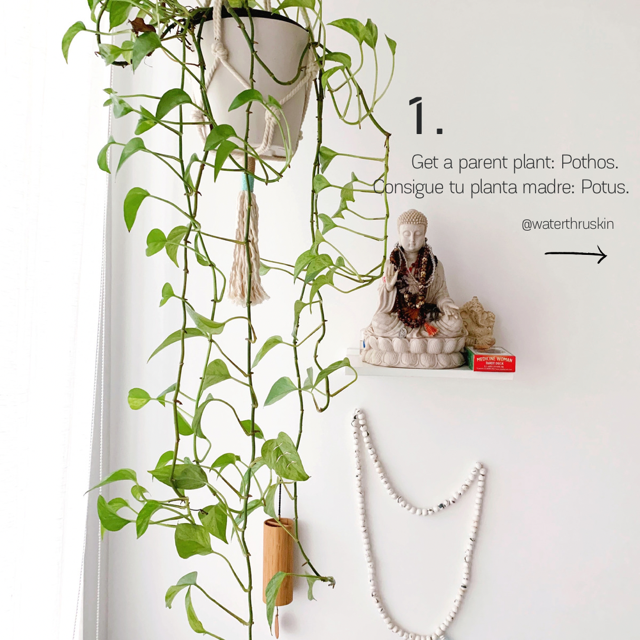Sustainability 101: Propagate/ Sustentabilidad 101: Propagar
Plants. They do not only add color and life to our homes but they also absorb toxins and purify the air we breathe. They are powerful and, now that we are spending so much time at home, crucial for our health! You’ve heard me use the term “propagate” dozens of times but I thought I should dive deeper into the importance of propagating.
First, what does “propagating” mean?
Propagating means reproducing plants from a parent plant. In plain English, you get to give birth to a new plant by cutting in between two nodes of a plant’s string, and placing the cut string in water. After a few weeks, roots will start to grow and you will witness the magic and power of nature to reproduce itself without much human help. All the new string needs is water and some light. I’ve been propagating plants at home for over 5 years now. It all started with a Pothos I bought 6 years ago. I fell so madly in love with how fast it grew that I began researching more about it, and learned about the practice of propagating Pothos. This 6-year old Pothos of mine has given me 10 new plants which we have placed all around our home.
Tips:
-In my experience, I came to realize that Pothos grow faster with company, meaning: add two cut strings to a vase with water. If you place a single one, it might take longer to grow. If you place them together, both will grow faster as if they fed on each other’s company.
-Plants filter their own water. On some Pothos, I do not have to change/clean their water at all; only add more. On others, I change the water every month or so.
-You can keep them in water or plant them in soil once they grow roots. Up to you!
-They are great for indoors and don’t need much attention but they do grow faster with sunlight or LED light.
Now, the sustainable and holistic facts! ☺
-Plants absorb toxic gases (VOCs) released from the paint in our walls, furniture and even cleaning products. Toxic VOCs like formaldehyde are detrimental to our health. This is one of the many reasons why I decorated and painted our home with nontoxic products and furniture, natural mattresses and lots of plants!
-Plants have been proven by research to uplift the energy at home and help our mental and emotional health.
-Propagating plants is affordable (almost free! You only have to purchase a parent plant!) and sustainable because you are not exploiting our natural resources (soil and water) nor using toxic pesticides in order to grow more plants! How about that for a fun sustainable step to decorate your home?
——————————————
(Español)
Plantas. No solo añaden color y vida a nuestros hogares, sino que también absorben toxinas y purifican el aire que respiramos. Son poderosas y, ahora que estamos pasando tanto tiempo en casa, ¡cruciales para nuestra salud! Me han escuchado usar el término "propagar" docenas de veces, pero creo que debería profundizar la importancia de propagar.
Primero, ¿qué significa "propagar"?
Propagar significa reproducir plantas de una planta madre. En lenguaje sencillo, puedes dar a luz a una nueva planta cortando entre dos nodos de la rama de una planta madre y colocando la rama cortada en agua. Después de unas semanas, las raíces comenzarán a crecer y serás testigo de la magia y el poder de la naturaleza para reproducirse sin mucha ayuda humana. Todo lo que necesita tu nueva planta es agua y algo de luz. He estado propagando plantas en casa durante más de 5 años. Todo comenzó con una planta de Potos/Potus que compré en el mercado hace 6 años. Me enamoré tan locamente de lo rápido que creció que comencé a investigar más sobre ella y aprendí sobre la práctica de propagarla. Este Potus ma de 6 años me ha dado 10 plantas nuevas que hemos colocado alrededor de nuestra casa.
Consejos:
-En mi experiencia, me di cuenta de que los Potus crecen más rápido con compañía, es decir: agrega dos ramas cortadas a un jarrón con agua. Si colocas una sola, es posible que tarde más en crecer. Si las colocas juntas, ambas crecerán más rápido como si se alimentaran de la compañía de la otra.
-Las plantas filtran su propia agua. En algunos Potus, no tengo que cambiar / limpiar su agua en absoluto; solo agreguo más. En otras, cambio el agua aproximadamente cada mes.
-Puedes mantenerlas en agua o plantarlas en el tierra una vez que echen raíces. ¡Depende de ti! -Son ideales para interiores y no necesitan mucha atención, pero crecen más rápido con luz del sol o luz LED.
¡Ahora, los datos sustentables y holísticos! ☺
-Las plantas absorben gases tóxicos (COV) liberados por la pintura de nuestras paredes, muebles e incluso productos de limpieza. Los COV tóxicos como el formaldehído son perjudiciales para nuestra salud. ¡Esta es una de las muchas razones por las que decoré y pinté nuestra casa con productos y muebles no tóxicos, colchones naturales y muchas plantas!
-Las plantas han sido probadas por investigaciones como elevadoras de energía en el hogar y fortalecedoras de nuestra salud mental y emocional.
-La reproducción de plantas es asequible (¡casi gratis! ¡Solo tienes que comprar una planta madre!) y sustentable porque no estás explotando nuestros recursos naturales (tierra y agua) ni usando pesticidas tóxicos para cultivar más plantas.
¿Qué tal esto para un paso divertido y eco-responsable para decorar tu hogar?














